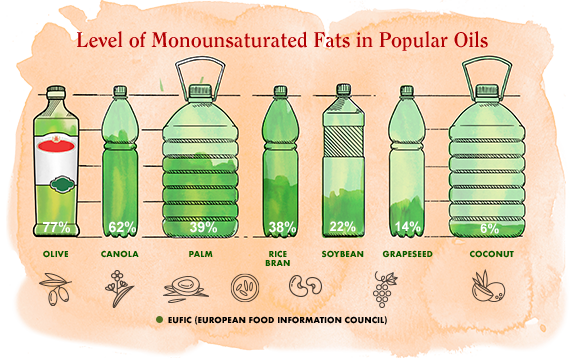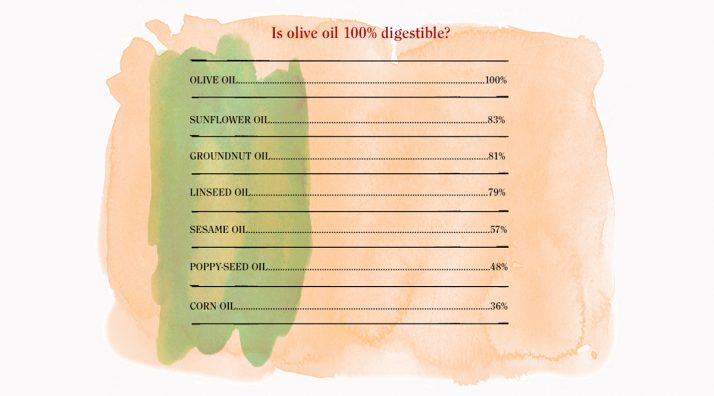Olive Oil Health Benefit
Get the facts about fats and learn how olive oil can be part of a healthy diet.
TYPES OF FATS IN OLIVE OIL
EUFIC (European Food Information Council)
Fats are a vital part of any diet. From supporting the absorption of vitamins to keeping your brain functioning well, you need fats to stay healthy. But not all fats are created equal and you need more of certain fats than others.
A key component of olive oil is monounsaturated fat, mainly oleic acid. Limited and not conclusive scientific evidence suggests that eating about two tablespoons (23 grams) of olive oil daily, may reduce the risk of coronary heart disease due to the monounsaturated fat in olive oil. To achieve this possible benefit, olive oil should replace a similar amount of saturated fat and keep the total number of calories you eat in a day.
OTHER BENEFITS OF OLIVE OIL
Olive oil is not only delicious, but healthy too! For example, olive oil contains more unsaturated fatty acids than butter, margarine and other oils. These unsaturated fatty acids replace the “bad” fats in our body, reducing our cholesterol levels as a result. Scientific research has shown that the use of olive oil greatly reduces the chance of a heart attack caused by the clogging of the blood vessels. Olive oil also contains natural antioxidants which protect our cells against ageing. Furthermore, olive oil leaves no waste products of any kind in the body as it is 100% digestible, unlike other oils.
Scientific research has shown that the use of olive oil greatly reduces the chance of a heart attack caused clogging of the blood vessels. Olive oil contains more unsaturated fatty acids than butter, margarine and other oils. These unsaturated acids replace the “bad” fats in our body, reducing our cholesterol levels as a result. Olive oil also contains antioxidants which protect our cells against ageing. Limited and not conclusive scientific evidence points out that eating approximately 2 tablespoons (23 g) of olive oil every day may reduce the risk of coronary heart disease thanks to the monounsaturated fats in olive oil. In order to attain this benefit, olive oil should replace a similar amount of saturated fats, and you should not increase the total number of calories you eat in a day.
Like any oil, olive oil contains fatty acids, but in the case of olive oil more than 70% of these fatty acids are monounsaturated fatty acids. This fatty acid has a more beneficial effect on the cholesterol in the body than polyunsaturated fatty acids (such as sunflower oil) based on linoleic acid. Linoleic acid reduces cholesterol in the absolute sense. Olive oil does this too, however not to the same extent as polyunsaturated fatty acids. However, what is more important is that olive oil also changes the composition of the cholesterol. In the case of olive oil, therefore, it works both ways. Olive oil changes the composition so that the “bad” cholesterol LDL decreases in respect of the “good” cholesterol HDL. It is precisely this good cholesterol HDL which prevents the clogging of the blood vessels, which can cause heart attacks. In addition, it leaves no waste products of any kind in the body, as it is 100% digestible.
Fats consists of three different types of fatty acids: saturated, monounsaturated and polyunsaturated fatty acids. Saturated fatty acids mainly occur in animal products. They can increase the level of cholesterol in the blood, thus increasing the chance of cardiovascular diseases. Monounsaturated and polyunsaturated fatty acids mainly occur in plant-based oils. Both types, but mainly monounsaturated fatty acids, can in fact reduce cholesterol levels.



